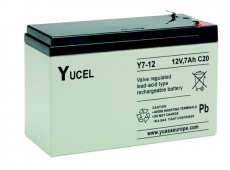Industrial Battery Gassing
This article discusses the gasses given off by Industrial Batteries and how to manage these gasses. The document primarily considers Standby Batteries but the overall principals apply equally to lead acid and nickel cadmium types both vented or VRLA.
Under normal operating conditions, the gasses evolved are hydrogen (H) and oxygen (O). However, under extreme conditions other gasses may be produced such as hydrogen sulphide (H2S). Some strange gasses are also given off in very small quantities such as carbon dioxide (CO2). This document only considers the evolution of hydrogen, oxygen and hydrogen sulphide.
Hydrogen will burn in air when in concentrations of between 4% and 75%. Oxygen in itself will not burn but does support combustion. Hydrogen sulphide is flammable and will explode and is very poisonous.

Lead-acid and nickel cadmium batteries only generate gases when on overcharge. However, gases can be seen to come from vented batteries with clear containers when on discharge. This is because gas will be present on the plate surface and within the active materials and when plates expand or contract when discharging, cells can appear to gas. VRLA batteries often “vent” on discharge because of the heat generated which causes the internal pressure to rise and the vent then opens to release the excessive pressure. In a quiet environment, a faint whistle sound can sometimes be heard.
Overcharge is a normal operating condition for all industrial batteries on float charge. The level of overcharge is very low and correspondingly, the volume of gas generated is also small but importantly it cannot be ignored. Batteries must not be placed in sealed rooms or enclosures.
The volume of the gas given off is, in the most part, proportional to the overcharge current. It should be noted that it is the charging current that produces gas and not the charging voltage. Normal float charge voltages result is low overcharge currents but a small increase in float voltage can result in a dramatic increase in float current. It is recommended that all float voltage systems are fitted with “over voltage shutdown control”. For VRLA batteries, a typical “over voltage shutdown control” voltage would be 2.40Vpc. At this voltage level the volume of gas given off is typically 7 to 10 times greater than the volume at the normal float voltage.
If the battery temperature is elevated, more gas is given off because more current will flow for the same float voltage. Typically, if the temperature increases by 10oC the volume of gas will double. In the extreme, a high battery temperature can lead to thermal runaway and hydrogen sulphide can be evolved in large quantities. This condition has to be avoided under all circumstances. Fortunately, hydrogen sulphide can be detected very easily because it has a foul odour of rotten eggs. If present, extreme caution should be taken when entering the battery room. It is recommended to isolate the charging source and allow the gas to disperse before entering the battery room.
For vented batteries, the charging current may be many times higher than for VRLA types. Vented batteries are often commission charged at constant current and a value of 10% C10 amperes as a constant value is normal. Comparing this to the current for a 100Ah VRLA battery, the current may be 0.2A at the “overvoltage shutdown control” voltage; similarly for a 100Ah vented lead-acid battery being commission charged at 10% C10A the current will be 10A. Considerably more ventilation will be required.
We need to manage these gasses to avoid disastrous consequences.
International standards give guidance to the ventilation requirements and people responsible for battery installations must be fully aware of the guidelines. Below you can find the formula for maintaining the hydrogen concentration below the 4% explosive limit. This formula is directly from BS EN 50272-2 and you MUST refer to the full document for the correct use of the formula.
Q = v . q . s . n . Igas . Crt . 10-3 [m3/h]
(The author does not accept any responsibility for the miss-interpretation or use of the above formula.)
Please follow our blog for continued technical information and advice relating to a full range of battery installations regarding both management, implementation and maintenance. Should you require particular assistance with a specific project then please do not hesitate to contact us directly for assistance. Our team are available to provide the necessary support you may need.